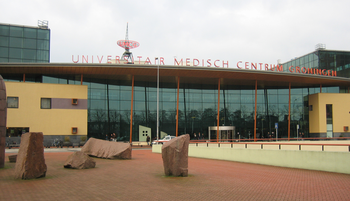
University Medical Center Groningen
Encyclopedia

The medical centre is affiliated with the Rijksuniversiteit Groningen. It is one of the largest hospitals in the world, offering supraregional tertiary care to the northern part of the Netherlands. The medical center employs almost 17000 people and counts almost 1400 beds. It is located in the center of Groningen.
The main building was opened in 1997 and its design is based on light and air. It counts 32 elevators that all have an different theme. Art plays an important role in the hospital, there are several exhibitions, statues, and a big fountain in the center of the hospital. The UMCG contains several shops; two coffee shops, a restaurant, a minimart, a candy & card store, a travel agency, a barber, a bookstore, a library for patients, and a Rituals flagstore. The ground floor is designed so that visitors would not feel as if they were in a hospital - the space is airy, there is a lot of green and the glass roofs are opened when the weather is fair.
Patient wards are on the outside of the building, so that all rooms have windows with a view. Each ward has a balcony that opens to one of the main 'streets' of the hospital. The operating center, ICU's and staff rooms are in the central part of the building. The UMCG is 4 storeys high, so that it would not rise above the rest of the city.
It is one of the world's largest centers for transplant surgery. All possible organ transplants are carried out at the UMCG, including combined transplants of multiple organs in one operation.
Special units include:
- Neurosurgery
- Cardiothoracic surgery (including transplants)
- Neonatal and pediatric surgery and intensive care
- Liver, kidney and bowel transplant surgery
- Pediatric oncology
- Level I trauma center (including trauma helicopter)
External links
- Official website (English version)

